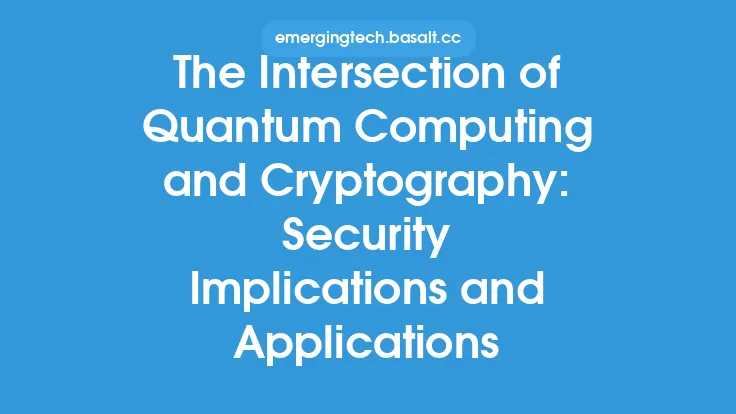The realm of quantum cryptography has emerged as a revolutionary approach to secure communication, leveraging the principles of quantum mechanics to encode and decode messages. This field has garnered significant attention in recent years due to its potential to provide unbreakable encryption, thereby safeguarding sensitive information from unauthorized access. At its core, quantum cryptography exploits the unique properties of quantum systems, such as superposition, entanglement, and measurement, to create secure communication channels.
Principles of Quantum Mechanics
Quantum mechanics is a fundamental theory in physics that describes the behavior of matter and energy at the smallest scales. In the context of quantum cryptography, several key principles are crucial. Firstly, the principle of superposition states that a quantum system can exist in multiple states simultaneously, which is a stark contrast to classical systems that can only be in one definite state. Secondly, entanglement refers to the phenomenon where two or more particles become correlated in such a way that the state of one particle cannot be described independently of the others, even when they are separated by large distances. Lastly, the act of measurement in quantum mechanics is not just a passive observation but an active process that can alter the state of the system being measured. These principles form the basis of quantum cryptography, enabling the creation of secure keys and the detection of eavesdropping.
Quantum Cryptography Concepts
Quantum cryptography encompasses a range of concepts and techniques designed to ensure secure communication. One of the foundational concepts is quantum key distribution (QKD), which allows two parties to securely exchange cryptographic keys. QKD relies on the principles of quantum mechanics to encode, transmit, and decode these keys in such a way that any attempt to eavesdrop on the communication would introduce errors, making it detectable. This is fundamentally different from classical cryptography, which relies on mathematical algorithms to secure data. Quantum cryptography also explores the use of quantum entanglement for secure communication, where entangled particles are used to encode and decode messages, offering a theoretically unbreakable method of communication.
Security Aspects
The security of quantum cryptography is rooted in the laws of physics rather than in computational complexity. This means that, unlike classical cryptographic systems which can be broken by sufficiently powerful computers, quantum cryptographic systems are secure against any potential eavesdropper, regardless of their computational power. The security is based on the no-cloning theorem, which states that it is impossible to create a perfect copy of an arbitrary unknown quantum state. This theorem ensures that any attempt to measure or eavesdrop on the communication would necessarily introduce errors, making the eavesdropping detectable. Furthermore, quantum cryptography systems can be designed to be provably secure, meaning that their security can be mathematically proven based on the principles of quantum mechanics.
Implementation and Challenges
Implementing quantum cryptography on a practical scale poses several challenges. One of the main hurdles is the difficulty in maintaining the coherence of quantum states over long distances, as decoherence (the loss of quantum coherence due to interaction with the environment) can quickly destroy the fragile quantum states required for secure communication. Additionally, the technology for generating, manipulating, and measuring quantum states is highly sophisticated and sensitive, requiring precise control over experimental conditions. Despite these challenges, significant advancements have been made in recent years, with the development of more robust quantum systems and the implementation of quantum cryptography in real-world scenarios, such as secure communication networks.
Future Directions
The future of quantum cryptography holds much promise, with ongoing research aimed at overcoming the current limitations and expanding its applications. One area of focus is the development of more efficient and reliable methods for quantum key distribution, including the use of satellite-based quantum communication systems to enable global secure communication. Another area of research is the integration of quantum cryptography with classical cryptographic techniques to enhance the security of existing communication systems. Furthermore, the exploration of new quantum systems, such as topological quantum computers, may offer even more secure and efficient methods for quantum cryptography in the future.
Conclusion
Quantum cryptography represents a significant leap forward in the field of secure communication, offering a level of security that is theoretically unbreakable. By leveraging the unique principles of quantum mechanics, quantum cryptography provides a solution to the growing need for secure data transmission in an increasingly interconnected world. While challenges remain in its implementation and scalability, the ongoing research and development in this field are poised to make quantum cryptography a cornerstone of future secure communication systems. As technology continues to evolve, the integration of quantum cryptography into our digital infrastructure could revolutionize the way we protect our information, ensuring that sensitive data remains secure against any form of eavesdropping or cyber attack.





